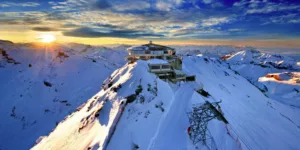The current ski and snowboarding season is in full swing but before hitting the slopes, the inevitable process of planning the trip has to be done. Planning a snow vacation can be a huge undertaking because of the multiple items that need to be considered: the weather, resort locations, prices, additional airline fees and the travel distance to ski resorts. The popularity of snow sports is indisputable with 481 ski resorts operating in the United States, over 13.91 million skiing participants and 7.6 million snowboarding participants in the United States alone.With such high demand for snow sports, here are some tips for a failsafe vacation.
Stay Flexible with Vacation Planning
The warm winter in the west coast this year has produced low snow levels, which in turn makes it hard to find the right time to visit a ski resort.Southern California saw various ski resorts such as Bear Mountain open as early as Thanksgiving last year. Yet, it could be possible that a warmer early season can lead to a longer winter in general.
Unlike other vacations not greatly affected by the weather, a snow vacation is highly dependent on (of course) the snow, so it is important to have flexibility with your planning.The coordination of scheduling a snow vacation along with the weather can be difficult, especially not knowing when the ski resorts are open. SnowPak, a skiing and snowboarding specialty travel website, offers a comprehensive list of the estimated opening and closing dates for over 200 major skiresorts.Mammoth Mountain in California opened on November 9, 2017 and has an estimated close date of July 2, 2018, meaning there’s still about seven months for skiers to make traveling arrangements and enjoy snow activities. Meanwhile across the border, Whistler Blackcomb in British Columbia opened on November 17, 2017 and has an estimated close date of May 16, 2018.
Research Before Visiting
Before heading on a snow vacation, it can be useful to research what is available at ski resorts and if it aligns with all the preferences in your ideal ski resort. A couple of key ski and snowboarding factors to take into account when researching resorts is the base, the vertical drop and the summit. A lengthy and informative section on these key data points and components for all major ski resorts worldwide can be found here, which can serve as a guide for comparing resorts.
Ski Resort Lift Ticket and Season Pass Prices
A major factor to consider when planning a snow vacation is the pricing for the ski resort lift tickets and the season pass prices. The price range for lift tickets can vary from ski resort, which makes the comparative search for prices a complex task. Another informative article by SnowPak shows all the resort lift ticket prices for the 2017/2018 season. For example, an adult lift ticket (ages 23-64) for Bear Mountain, California costs $89. Keeping in mind the amount of the resort lift ticket price, the only one left to calculate is the price of the actual ski resort. Here is an in-depth infographic displaying extensive information at a glance, such as comparisons between popular ski passes such as the Epic Pass, Rocky Mountain Super Pass, Mountain Collective and the MAX Pass.
Baggage Fees
When traveling with any airline, there are special baggage policies for skis and snowboards to be aware of, such as the price for overweight baggage. However, different airlines have varying policies that specify what constitutes overweight baggage as exceeding their set weight limit or exceeding the prescribed size limit. Here’s a detailed list of major airlines and their individual baggage policies which simplifies the process of having to research each airline one by one.
Maximize Your Ski Time
When rushing to the airport, it can be easy to make an estimate of the time it will take to travel the distance from the airport to the ski resort, but why guess when there’s a handy reference guide that assembled an approximation of the drive times and distance between ski resorts and gateway airports. Maximize your ski time by going into your trip knowing the approximate driving time it’ll take, the traveling distance, and benefit from learning potential short cuts.








